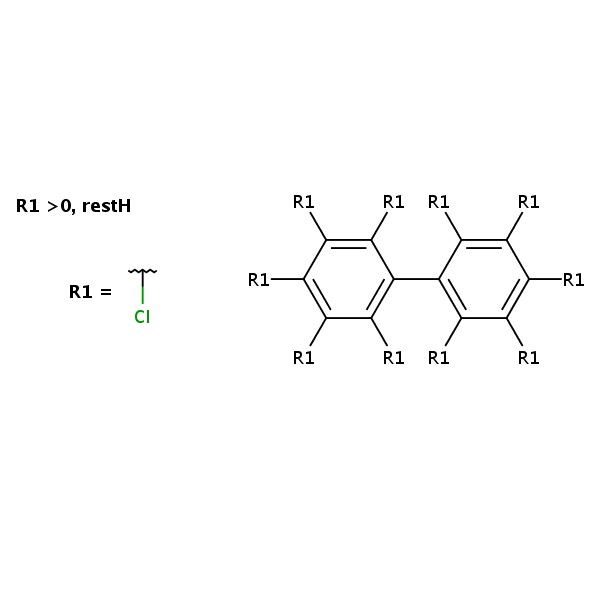Polychlorinated Biphenyls (PCBs)
CASRN 1336-36-3 | DTXSID5024267
- IRIS Summary (PDF) (22 pp, 146.5 KB, about PDF)
- Status: polychlorinated biphenyls (pcbs) is in step 1 at this time.
Mixtures Modeling Methods: Applications for Assessing Polychlorinated Biphenyls (PCBS) (Webinar)
On this page:
Meeting Agenda
EPA is currently updating its Integrated Risk Information System (IRIS) assessment of polychlorinated biphenyls (PCBs). This assessment addresses selected noncancer human health effects that might result from exposure to these chemicals. PCBs are a class of synthetic compounds characterized by a biphenyl structure with chlorine substitutions at up to 10 positions. There are 209 well-defined PCBs known as "congeners" based on the various combinations of the numbers and positions of the chlorine substitutions on the biphenyl molecule. PCB congeners vary both structurally and in their toxicity in humans and animals. PCBs were synthesized as mixtures of congeners, and the composition of commercially produced PCB mixtures can vary substantially from mixtures humans are currently exposed to in the environment. Most health effect studies of PCBs in animals have been conducted using commercial mixtures, and there are no data to represent many environmental mixtures of concern for human health risk assessment. Therefore, methods for translating experimental data from tested to untested mixtures would be useful, including methods for addressing PCB mixtures with varying proportions of congeners that act via different biological pathways. For these reasons, EPA is evaluating approaches for assessing chemical mixtures for use in the assessment. To that end, EPA is developing the Mixtures Similarity Tool (MiST). MiST is a Microsoft Excel® based tool, which automates the process of evaluating the degree to which chemical mixtures are similar in their ability to cause health effects and whether they are “sufficiently similar” for risk assessment applications. MiST identifies PCB mixtures with well-characterized dose-response information (i.e., reference mixtures) that are “sufficiently similar” to a specific candidate mixture that may not have dose-response information. Dose-response data for a sufficiently similar reference mixture could be used to assess toxicity for the candidate mixture.To facilitate discussion of scientific issues pertinent to evaluation of mixture similarity and the potential for application of mixtures modeling methods in the PCB assessment, EPA hosted a public webinar.
Webinar Details
EPA hosted a public webinar to discuss mixtures assessment approaches related to the IRIS assessment of PCBs. The webinar focuses on the evaluation of similarity of chemical mixtures for risk assessment applications, supported by the draft EPA Mixtures Similarity Tool (MiST). The webinar consists of four presentations on the following topics: EPA’s human health risk assessment practices for chemical mixtures; mixtures modeling approaches considered for the IRIS PCB assessment; methods for estimating relative potency values; and an overview of the MiST.
- Agenda: See downloads tab.
- Date: March 16, 2022
Meeting Materials
- PCB Mixtures Modeling Methods Meeting Agenda (Mar 2022) (PDF) (2 pp, 170.9 KB, about PDF)
- Talk 1: Introduction to EPA’s Human Health Risk Assessment Practices for Chemical Mixtures (PDF) (31 pp, 475.6 KB, about PDF)
- Talk 2: Mixtures Modeling: Methods Considered for the Assessment of Polychlorinated Biphenyls (PCBs) (PDF) (36 pp, 1.0 MB, about PDF)
- Talk 2: Speaker Notes (PDF) (9 pp, 250.0 KB, about PDF)
- Talk 3: Methods for Estimating Relative Potency Values (PDF) (38 pp, 2.7 MB, about PDF)
- Talk 4: Mixtures Similarity Tool (MiST) (PDF) (40 pp, 656.2 KB, about PDF)
- Talk 4: Speaker Notes (PDF) (9 pp, 184.6 KB, about PDF)
If you have a disability and the format of any material on our web pages interferes with your ability to access the information, please reach out to us using the Contact Us about IRIS form for assistance. To enable us to respond in a manner most helpful to you, please indicate the nature of the accessibility problem, the web address of the requested material, your preferred format in which you want to receive the material (electronic format (ASCII, etc.), standard print, large print, etc.), and your contact information.
Quick Check

Related Links
Tumor Sites
Chemical Structure for
Polychlorinated Biphenyls (PCBs)

Synonyms
- Aroclor
- Aroclor 1221
- Aroclor 1232
- Aroclor 1242
- Aroclor 1248
- Aroclor 1254
- Aroclor 1260
- Aroclor 1262
- Aroclor 1268
- Aroclor 2565
- Aroclor 4465
- Aroclor 5442
- Biphenyl, polychloro-
- Chlophen
- Chlorextol
- Chlorinated biphenyl
- Chlorinated diphenyl
- Chlorinated diphenylene
- Chloro 1,1-biphenyl
- Chloro biphenyl
- Clophen
- Dykanol
- Fenclor
- Inerteen
- Kanechlor
- Kanechlor 300
- Kanechlor 400
- Montar
- Noflamol
- PCB
- PCBs
- Phenochlor
- Phenoclor
- Polychlorinated biphenyl
- Polychlorinated biphenyls
- Polychlorinated biphenyls (PCBs)
- Polychlorobiphenyl
- Pyralene
- Pyranol
- Santotherm
- Santotherm fr
- Sovol
- Therminol fr-1
- UN 2315
- 1336-36-3

